Class:
Gastropoda
![]() Subclass:
Pulmonata
Subclass:
Pulmonata
![]() Superorder:
Basommatophora
Superorder:
Basommatophora
![]() Order:
Hygrophila
Order:
Hygrophila
![]() Suborder:
Branchiopulmonata
Suborder:
Branchiopulmonata
![]() Infraorder:
Acroloxoinei
Infraorder:
Acroloxoinei
![]() Superfamily:
Acroloxoidea
Superfamily:
Acroloxoidea
![]() Family:
Acroloxidae Thiele 1931
Family:
Acroloxidae Thiele 1931
![]() Infraorder:
Planorboinei
Infraorder:
Planorboinei
![]() Superfamily:
Planorboidea
Superfamily:
Planorboidea
![]() Family:
Planorbidae Gray 1840
Family:
Planorbidae Gray 1840
![]() Source:
Mollbase on
http://www.mollbase.de/list/.
Source:
Mollbase on
http://www.mollbase.de/list/.
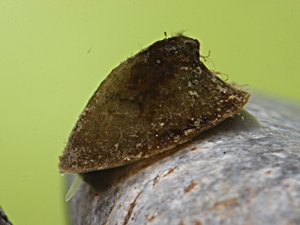 River limpet (Ancylus fluviatilis). Picture: © Alexander Mrkvicka, Vienna (mrkvicka.at). |
With limpets living on the coast, the fresh water living limpets only have in common the name and to a certain extent the shape of their shell. The three species native to Germany and Austria, however, have evolved in different groups of water-living pulmonate snails (Basommatophora) by convergent evolution: They are only more or less distantly related to each other. They can, however, be distinguished by the form of their shell: The lake limpet's (Acroloxus lacustris) shell is flat, the shell-tip (apex) is sharp and tilted to the left. In contrary to that, the river limpet's (Ancylus fluviatilis) shell is cup-shaped, the apex is blunt and tilted to the rear. The flat freshwater chamber limpet's (Ferissia clessiniana) shell finally resembles that of a lake limpet, only the glassy shell's tip is blunt and tilted to the right.
Whereas the lake limpet (Acroloxus lacustris) is a part of a superfamily on its own, the Acroloxoidea (of which there is only one native family, the Acroloxidae), the river limpet (Ancylus fluviatilis) and the chamber limpet (Ferissia clessiniana) have evolved from the ram's horn snails (Planorbidae).
![]() Fresh water snails Part 2:
The ram's horn snail (Planorbarius corneus).
Fresh water snails Part 2:
The ram's horn snail (Planorbarius corneus).
Lake limpet - Acroloxus lacustris (Linnaeus 1758)
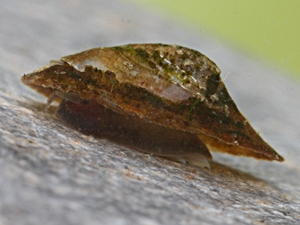 Lake limpet (Acroloxus lacustris). Picture: © Alexander Mrkvicka, Wien (mrkvicka.at). |
Description: The form of a lake limpet's shell, already mentioned earlier, is dependent on the substrate it lives on. Lake limpets living on slender plant stems have a longish elevated shell, those living on stones and rocks have a broad, oval and longer shell instead.
Dimensions: H: 2 mm; L: 7 mm; W: 3 mm. (Abbreviations).
Habitat and Distribution: Lake limpets live in stagnant and slow-streaming waters rich in vegetation. Their distribution area covers central and eastern Europe, from the Pyrenees as far east as the Volga, in the north until Ireland, south Norway, Sweden and Finland, as well as St. Petersburg.
![]() Mollbase: Systematic Information about the
Lake
limpet, Acroloxus lacustris (Linnaeus
1758).
Mollbase: Systematic Information about the
Lake
limpet, Acroloxus lacustris (Linnaeus
1758).
![]() Systematics of Gastropoda:
Informal Group Pulmonata: Acroloxidae.
Systematics of Gastropoda:
Informal Group Pulmonata: Acroloxidae.
River Limpet -Ancylus fluviatilis (O. F. Müller 1774)
Dimensions: H: < 4 mm; L: 5 - 6 mm; W: 4 - 5 mm. (Abbreviations).
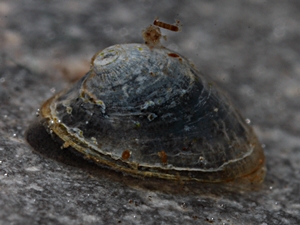 River limpet (Ancylus fluviatilis). |
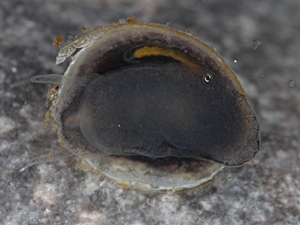 Foot of a river limpet (Ancylus fluviatilis). Pictures: © Alexander Mrkvicka, Vienna (mrkvicka.at). |
Habitat and Distribution: River limpets prefer streaming water of all kinds. They can be found on stones in streaming waters with sufficient oxygen content, from the spring to the major river, also in Karst springs. Especially in North and West Europe, river limpets also inhabit the surf zone of lakes, where the water contains more oxygen. Very rarely, river limpets also sit on water plants. Form and size of their shell is dependent on environmental conditions, such as substrate and water quality, and so it is quite variable.
Ancylus fluviatilis is found in nearly all of Europe, north Africa and the Near East. The species' distribution area stretches from North Africa and the Iberian Peninsula east as far as St. Petersburg, lake Ladoga and the Volga, in the south to the Mediterranean, in the north as far as Ireland, England, southern Norway and Sweden. In Finland there are river limpets as far north as 65° N. L.
However it is assumed, that the river limpet populations from the Mediterranean largely represent independent species.
As are lake limpets, river limpets have been known as fossils at least since
the Upper Pliocene, about 2.6 to 1.77 mio. years ago. Ancylus
fluviatilis is an important indication fossil in the Baltic Sea evolution,
when the Baltic Sea was an inshore freshwater lake, the so-called Ancylus
lake, 9500 to 8000 years ago (![]() See Map).
See Map).
Chamber Limpet - Ferrissia (Pettancylus) clessiniana (Jickeli 1882)
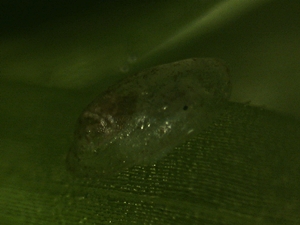 Chamber limpet (Ferrissia clessiniana). Picture: © Alexander Mrkvicka, Vienna (mrkvicka.at). |
Description: The chamber limpet has an oval shell with a blunt apex titled to the right (in contrary to the lake limpet (Acroloxus lacustris), whose apex is tilted to the left). The name chamber limpet is because the snail can build a septum in the rear part of the shell to protect against dryness. Later, shell growth will begin there again.
Dimensions: L: 3 - 4 mm; W: 1.4 - 1.7 mm; H: 0.8 - 1.2 mm. (Abbreviations). Occasionally, the shell length may amount to 6 mm.
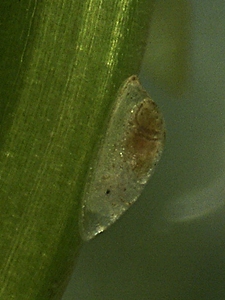 Chamber limpet (Ferrissia clessiniana). Picture: © Alexander Mrkvicka, Vienna. |
Habitat and Distribution: Chamber limpets usually live in stagnant and slow moving waters rich in vegetation in depths of up to 1 m, where the snail lives under leaves and on stems of water plants. The chamber limpet tolerates hypertrophic conditions as the result of over-fertilisation and is also adapted to temporary drying-out (see above).
In Europe there are several species of chamber limpets, the division of which is not entirely clear. Basically it is assumed that chamber limpets are neozoa, which were introduced from North America (Walther, 2006, as Ferrissia fragilis) or North Africa (Kerney, 1999). Ferrissia clessiniana is assumed to be an autochtonous species in the Mediterranean and the Danube countries, evolved in those places.
Chamber limpets originally are distributed in North America, have been introduced to Europe and East Asia, where they have further distributed on their own. Ferrissia clessiniana is often confounded with the lake limpet (Acroloxus lacustris) because of their great external similarity. Therefore the assumption is that chamber limpets are more widely spread, than previously thought.
 In
their area of distribution, chamber limpets are threatened by the change of
their habitats because of drainage and construction - in Switzerland most
habitats of the species have already been destroyed. In Switzerland and Austria,
chambered limpets are thought to be endangered (EN), in England and Wales, on
the contrary, the species seems to be spreading.
In
their area of distribution, chamber limpets are threatened by the change of
their habitats because of drainage and construction - in Switzerland most
habitats of the species have already been destroyed. In Switzerland and Austria,
chambered limpets are thought to be endangered (EN), in England and Wales, on
the contrary, the species seems to be spreading.
Literature
![]() Kerney,
M. (1999): Atlas of the land and freshwater molluscs of Britain and Ireland.
Kerney,
M. (1999): Atlas of the land and freshwater molluscs of Britain and Ireland.
![]() Walther,
A. C., Lee, T., Burch,
J. B., Ó Foighil, D. (2006):
Confirmation that the North American ancylid Ferrissia fragilis (Tryon,
1863) is a cryptic invader of European and East Asian freshwater ecosystems. -
J. Moll. Stud. 72 (3): 318-321.
Walther,
A. C., Lee, T., Burch,
J. B., Ó Foighil, D. (2006):
Confirmation that the North American ancylid Ferrissia fragilis (Tryon,
1863) is a cryptic invader of European and East Asian freshwater ecosystems. -
J. Moll. Stud. 72 (3): 318-321.
![]() Walther,
A. C., Lee, T., Burch,
J. B., Ó Foighil, D. (2006):
Acroloxus lacustris is not an ancylid: a case of misidentification involving
the cryptic invader Ferrissia fragilis (Mollusca: Pulmonata: Hygrophila).
- Molecular Phylogenetics and Evolution 39: 271 - 275.
Walther,
A. C., Lee, T., Burch,
J. B., Ó Foighil, D. (2006):
Acroloxus lacustris is not an ancylid: a case of misidentification involving
the cryptic invader Ferrissia fragilis (Mollusca: Pulmonata: Hygrophila).
- Molecular Phylogenetics and Evolution 39: 271 - 275.
Links
![]() Francisco Welter-Schultes:
Ferrissia clessiniana species homepage.
Francisco Welter-Schultes:
Ferrissia clessiniana species homepage.